11029 AN UNUSUAL PAIR OF CARVED BIRDS EYE MAPLE AESTHETIC PERIOD ARMCHAIRS Probably New York. Circa 1870. Measurments: Height: 33 1/2″ (85 cm) Depth: 32″ (81.3 cm) Width: 26″ (66 cm).
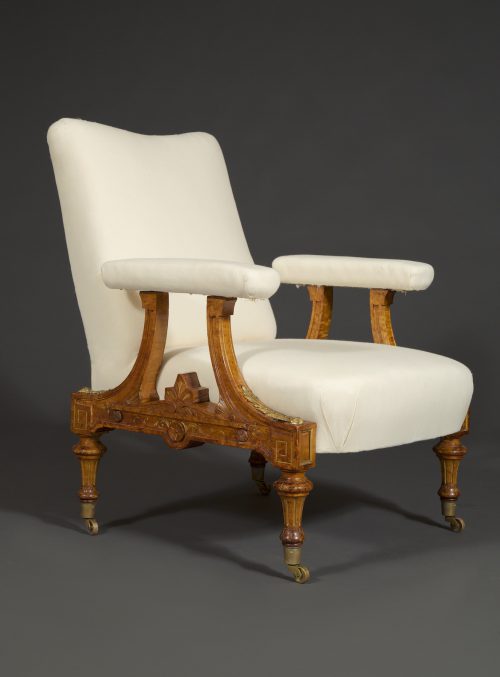
Research
Of solid birds eye maple. Gilt brass mounts parcel gilding. The incurved rectangular back rests upon an apron whose sides are carved with incised Greek key and arabesque motifs and surmounted by carved stylized acroteria. Detachable foliate roundels conceal steel fixing bolts. The armrests are raised on acanthine gilt brass mounted incurving supports. The whole raised on carved and fluted toupie form legs. Several roundels are old replacements. Castors replaced.
Marks:
Hand painted number on one leg:
1991.943
This unusual pair of armchairs is an example of Aesthetic movement design of the 1870s and 1880s, which “emphasized art in the production of furniture, metalwork, ceramics, stained glass, textiles, wallpapers, and books.”1 Common characteristics in Aesthetic furnishings during this period were exotic ornament, motifs featuring elements found in nature, and decorative inlays and gilt highlights. At this time New York “was considered the style center of America,”2 and one firm who enjoyed great success in this genre was Pottier & Stymus.
Auguste Pottier (1823-1896) was born in Coulommiers, France and by the age of 14 was an apprentice to a Parisian wood sculptor. In 1847 he traveled to New York City and was working for E.H Hutchings & Sons as a journeyman sculptor by 1850. Here he met Gustave Herter who shortly after would become his first business partner when they opened Herter, Pottier & Company in 1851. Although no examples of the collaboration with Herter are known, a trade card for the firm depicts rococo revival furniture. By the late 1850s Pottier had moved on to another New York firm, Rochefort and Skarren, where he served as a general foreman. It was here that he met William Stymus, who was working as a foreman in the upholstery room. Stymus (b. 1830) was born in New York City and had entered Rochefort and Skarren at the young age of sixteen.
Together, Pottier and Stymus went on to found their own cabinetmaking and upholstery business in 1859, the first of which was located at 623 Broadway where they set up a workshop and sale room. By the 1870s they had moved and expanded their premises several times, with the main factory located in an impressive Italian-style building at 325 Lexington Avenue.
At their height the firm had taken on over 700 employees and achieved sales totaling more than $1 million.3 Their furniture, crafted largely in the Renaissance- and Greek-revival styles, employed lavish woodworking, inlays, and gilt incised decoration. The factory, described in great detail in the The Golden Book of Celebrated Manufacturers and Merchants in the United States (1875), was “divided into ateliers or workshops,” including bronze casting, mosaic and painting, cabinetmaking, lock manufacturing, veneering, and upholstering departments to name but a few.
Two of the firm’s most important early commissions were for the Treasury Department under President Andrew Johnson and the President office and Cabinet Room of the White House under Ulysses S. Grant. These government commissions “came at a pivotal moment in bolstering the Nation’s identity” and the furniture suites “associated the contemporary American government with illustrious past republics of Greece and Rome, emphasizing the United States’ power, solidity and longevity.”4
In 1875 Pottier & Stymus took on the large project of exhibiting at the Philadelphia Centennial Exhibition in 1876, preparing a completely furnished apartment of three rooms in less than 100 days,5 and their success at the Exhibition solidified their reputation as one of the leading American furniture companies. Their “responsiveness to the taste of rising American millionaires, who desired opulent artistic houses that showcased the owner’s individuality and had distinct decoration and furniture,”6 secured the firm commissions from some of the wealthiest and most important businessmen in the nation, including Henry Flagler, William Rockefeller, Leland Stanford.
Because Pottier & Stymus worked in a variety of different styles, and because their trade catalogs and company records were destroyed in a fire at the warehouse in 1888, it is particularly difficult to attribute pieces to the firm. However, select characteristics are shared between the present chairs and items by or attributed to Pottier & Stymus, providing the possibility that they may also have formed part of the firm’s oeuvre. In particular, an armchair and low side chair from a suite in the Metropolitan Museum of Art employs related geometric decoration, incised gilt lines, and armrests of unique, downswept form (figure 1). Interestingly, the similarly incurved “triangular” armrests in both examples are attached to the seat frame, rather than the backrest. A neo-Grec tiger maple bedroom suite, sold in the New York art trade, also shares similarly drawn gilt incised decoration and foliate roundels (figure 2).
A further point of note, one of the chairs bears the hand painted label 1991.943, almost certainly a museum accession number.
Footnotes:
1. Doreen Bolger. In Pursuit of Beauty: Americans and the Aesthetic Movement. New York: Metropolitan Museum of Art, 1986.19.
2. Ibid., 156.
3. Keys, Leslee F. Preserving the Legacy: The Hotel Ponce de Leon and Flagler College. Thesis. University of Florida. 2013. 167.
4. Varner, Elizabeth Chantale. Bolstering a National Identity: President Andrew Johnson’s Pottier & Stymus Furniture in the United States Tresury Department, 1865. Thesis. The Smithsonian Associates and Corcoran College of Art + Design. 2008. 1.
5. Lutgens, Ruth. The Pottier & Stymus Manufacturing Company’s 1876 Centennial Exhibition Furniture. Thesis. Sotheby’s Institute of Art. 2011.15.
6. Ibid., 7.
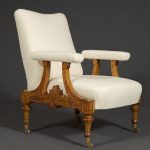

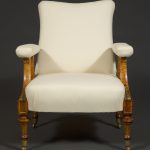
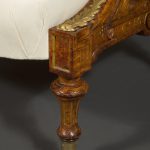
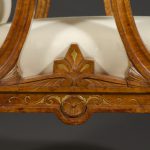
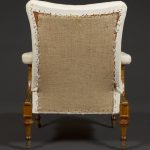
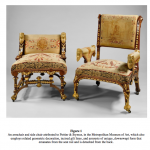
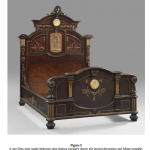
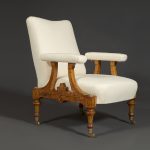
Comments are closed.